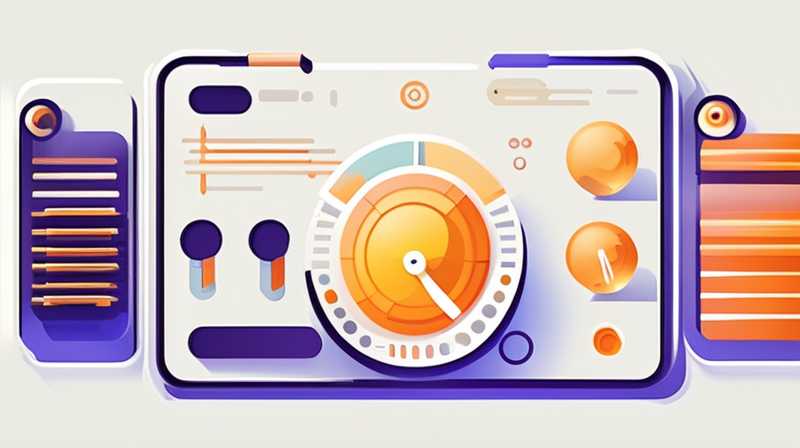
How to install solar energy measurement and control instruments
To successfully install solar energy measurement and control instruments, follow these essential steps: 1. Assess your energy needs and system compatibility, 2. Choose the appropriate instruments for your solar setup, 3. Properly configure the installation site to ensure optimal performance, 4. Execute installation with precision and adherence to safety standards, 5. Test and calibrate instruments to guarantee accurate readings.
1. ASSESS ENERGY NEEDS AND SYSTEM COMPATIBILITY
Understanding energy requirements is pivotal in selecting the correct solar measurement and control instruments. First and foremost, a detailed analysis of the energy consumption patterns is essential. This involves examining past energy bills, identifying peak consumption times, and recognizing any seasonal variations. Accurate comprehension of these patterns aids in the selection of an appropriate solar setup that can meet the specific demands of a household or business.
System compatibility also plays a vital role in this process. Not every instrument will work seamlessly with existing solar systems. Therefore, it is beneficial to research various instruments, such as inverters, meters, and data loggers, while evaluating their compatibility with the solar panels and battery storage systems already in place. This step ensures that the chosen instruments can effectively integrate into the current environment without causing interference or malfunction.
2. CHOOSE APPROPRIATE INSTRUMENTS
Once energy needs and compatibility have been established, the next course of action is to select the appropriate instruments for measurement and control. A variety of instruments exist, each serving distinct functions. For instance, solar irradiance sensors measure the sunlight received, while energy meters monitor the amount of electricity generated and consumed by the system.
When choosing these instruments, it’s crucial to prioritize quality and reliability. Instruments from reputable manufacturers tend to have better performance, accuracy, and durability. Reading user reviews, seeking recommendations from professionals, and evaluating product specifications can help in making an informed decision. Additionally, selecting instruments with advanced features such as remote monitoring capabilities can enhance the overall efficiency of the solar energy system.
3. CONFIGURE INSTALLATION SITE
Proper configuration of the installation site significantly influences the performance of solar energy measurement and control instruments. To begin with, consider the physical placement of these instruments. They should be installed in locations that minimize exposure to obstructions, such as trees or buildings, which can cast shadows and affect the readings.
Moreover, environmental factors like temperature and humidity should be taken into account. Instruments exposed to extreme temperatures may yield inaccurate data or, worse, fail completely. Therefore, ensuring that the installation area is both accessible for monitoring and sheltered from harsh weather conditions is essential for long-term functionality.
4. EXECUTE INSTALLATION WITH PRECISION
With instruments selected and the site configured, the actual installation process begins. This phase requires meticulous attention to detail. Each instrument must be mounted securely and in accordance with the manufacturer’s guidelines. This often includes using appropriate brackets, screws, and seals to ensure durability.
During the installation, check the connections of wires and cables thoroughly to prevent potential issues. Correct wiring is essential for accurate signal transmission between instruments. take particular care in ensuring that positive and negative terminals are connected correctly to avoid short circuits or improper functionality.
5. TEST AND CALIBRATE INSTRUMENTS
After installation, the next critical step involves testing and calibrating the instruments to ensure that they operate correctly. Testing provides insight into whether the instruments are functioning as intended and can yield accurate readings. This step often includes examining the displays and verifying that the data collected aligns with expectations.
Calibration is also crucial as it involves adjusting instruments to ensure their accuracy relative to a standard. This process may require specific tools and adherence to manufacturer procedures. Regular calibration ensures that instruments maintain precision over time, providing reliable data for energy management decisions.
FAQs
WHAT TYPE OF SOLAR ENERGY MEASUREMENT INSTRUMENTS DO I NEED?
Selecting the right solar energy measurement instruments requires a careful evaluation of your system’s specific needs. Typically, you need irradiance sensors, energy meters, and battery management systems. Irradiance sensors measure solar radiation levels while energy meters track the electricity generated and consumed. If storage is involved, a battery management system monitors the charge and discharge cycles, ensuring efficiency and safety. Always assess the compatibility of these devices with your existing system, and opt for quality products that offer reliable performance.
HOW DO I CALIBRATE MY SOLAR ENERGY MEASUREMENT INSTRUMENTS?
Calibrating solar energy measurement instruments is essential for ensuring accurate data collection and performance. The calibration process typically involves comparing the instrument’s readings to a known standard. Start by consulting the manufacturer’s guidelines on calibration procedures for the specific instruments you have. You may need a reference meter or known light source to compare readings. Adjust the instrument settings accordingly, paying attention to environmental factors that may affect accuracy, such as temperature. Regular calibration intervals are crucial to maintain reliable performance.
WHAT COMMON MISTAKES SHOULD I AVOID DURING INSTALLATION?
Several common mistakes can jeopardize the effectiveness of solar energy measurement instruments. One frequent error is improper mounting, which may lead to inaccurate readings due to obstructions or incorrect angles. Additionally, neglecting to check electrical connections during installation can result in data loss or malfunction. Ensure that you thoroughly read the manufacturer’s instructions before installation. Conducting meticulous tests post-installation is also vital; failure to do so could result in overlooking crucial calibration needs.
With a focus on accurate execution, following these steps can significantly improve the efficiency and reliability of your solar energy measurements. Proper installations, assessments, and calibrations contribute to the overall success of solar energy technologies. Carefully considering the instruments and their configuration will ensure the highest levels of functionality and performance, ultimately leading to enhanced energy efficiency and effective management.
Original article by NenPower, If reposted, please credit the source: https://nenpower.com/blog/how-to-install-solar-energy-measurement-and-control-instruments/


